- All Products
- SpheroTribe - all-in-one kit for reproducible spheroid/organoids
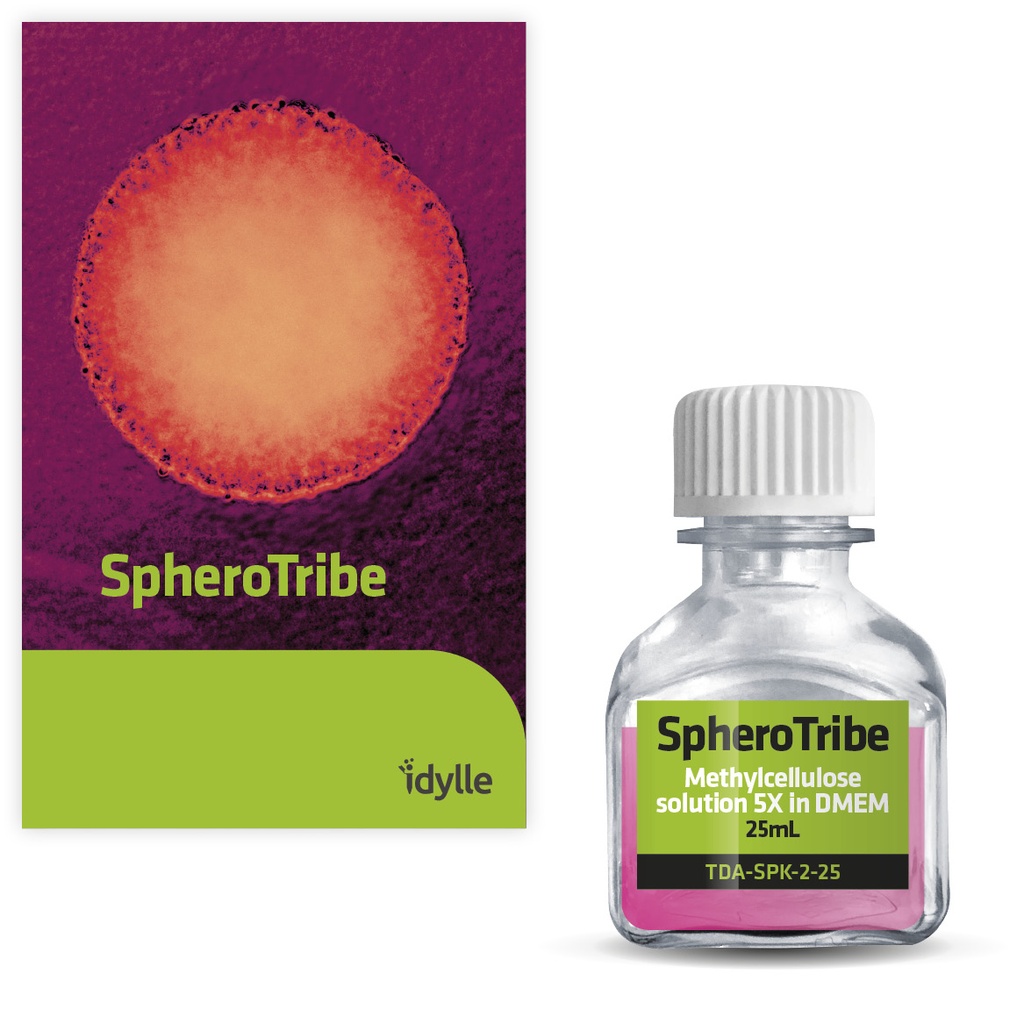
SpheroTribe - all-in-one kit for reproducible spheroid/organoids
https://www.idylle-labs.com/shop/spherotribe-all-in-one-kit-for-reproducible-spheroid-organoids-409 https://www.idylle-labs.com/web/image/product.template/409/image_1920?unique=4286f13The all-in-one kit for reproducible 3D cell culture
The kit includes:
- 5X methylcellulose solution
- U-bottom 96-well plates
- pipette tips with a large opening of 200µL
SpheroTribe was initally developed by Thomas Daubon's research team (CNRS - IBGC - Université de Bordeaux, France)
SpheroTribe provides a simple toolkit to generate consistent and robust 3D cell structures (spheroids, organoids) without restriction of cell type. Simply dilute the SpheroTribe solution into your culture medium of choice, watch your cells turn into uniformly sized 3D spheroids and collect them for your downstream assays.
Once diluted in your culture medium of choice, our concentrated polymer-based solution increases the medium viscosity favouring cell-cell contacts. SpheroTribe offers a simple method to generate homogeneous 3D cell structures with increased control over their size and shape, which can be easily handled and washed for downstream experiments.
SpheroTribe is particularly useful to boost aggregation when working with challenging cells, minimize variability between samples and improve the consistency of your in vitro assays (i.e. migration, proliferation, invasion or immune cell infiltration), immunostaining procedures, drug screening or in vivo implantation experiments.
Kit description of SpheroTribe
In addition to the SpheroTribe solution, the full kit also includes U-bottom plates and wide-opening tips so you have everything you need to get started with your 3D cell culture experiments.
25mL kit (960 spheroids):
- 25mL of 5X methylcellulose solution
- 10x U-bottom 96-well plates
- 2x racks of 96 pipette tips (200µL) with a large opening
2,5mL kit (96 spheroids):
- 2.5mL of 5X methylcellulose solution
- 1x U-bottom 96-well plate
- 20 pipette tips (200µL) with a large opening
Storage recommendation for the methylcellulose solution:
4°C for (at least) 10 months.
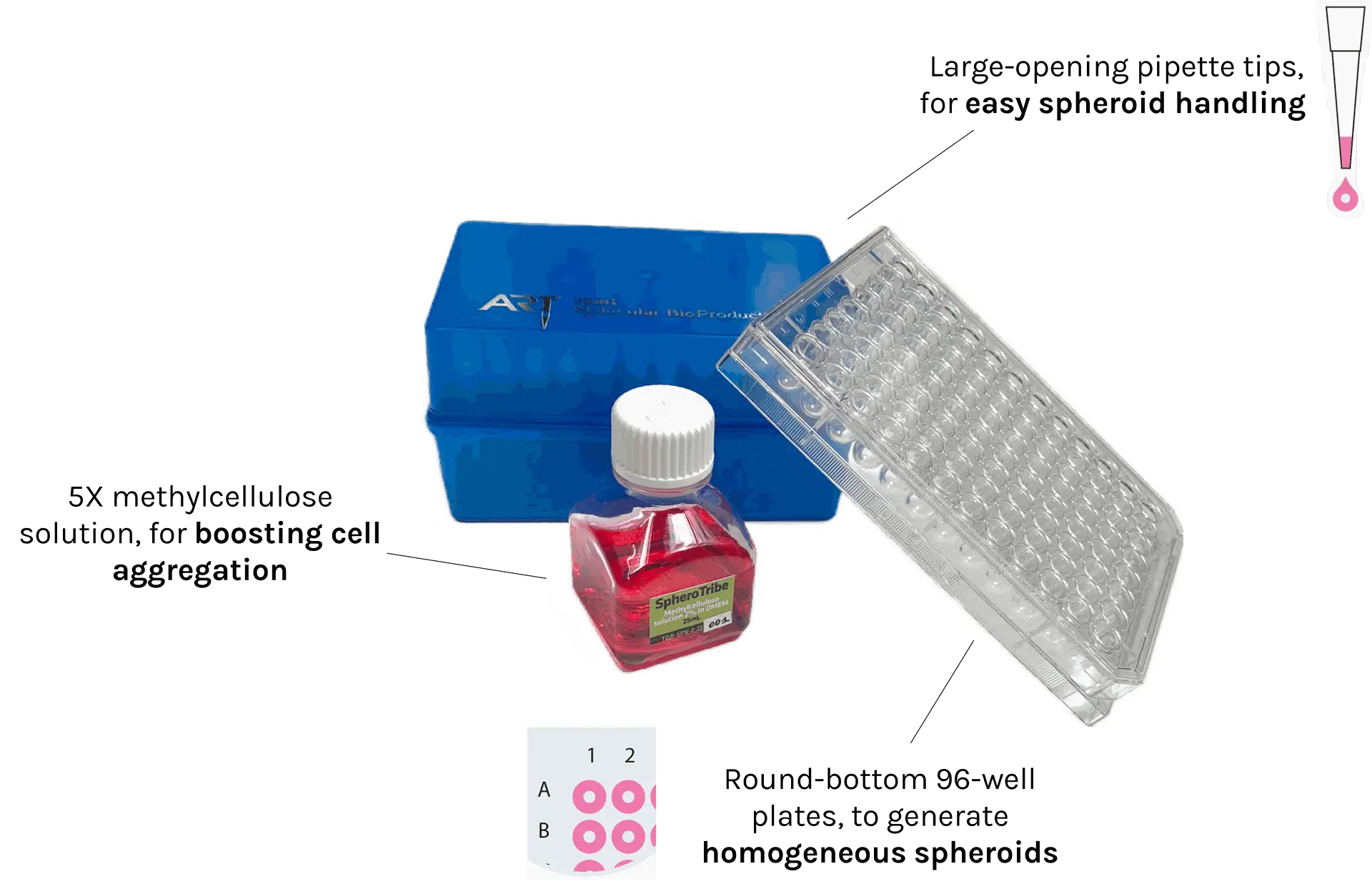
Cell aggregation booster
SpheroTribe provides a gel-like scaffold that favors cell-cell contacts by increasing medium viscosity. It was shown to generate compact spheroids mimicking solid tumors, improve spheroid formation with some of the most challenging cells and to speed up stem cell-derived organoid formation.
Increased homogeneity
By maximizing cell aggregation, SpheroTribe promotes the formation of unique & uniformly sized spheroids allowing for consistent assays (growth, invasion, immune infiltration, in vivo injection, etc).
Easy to use
No need to work on ice, have access to sophisticated equipment of expertise. With SpheroTribe, you have everything on hand to easily grow & handle your spheroids.
Universal
The SpheroTribe solution is composed of methylcellulose, a biologically inert compound dissolved in basal culture medium without any proteins, lipids or growth factors. You can dilute it in any culture medium of your choice, and add additional compounds as desired (i.e. serum, antibiotics, differentiation factors, etc).
Applications of SpheroTribe:
So far, SpheroTribe has been successfully used for spheroid/organoid formation with the following cell types:
Human cells: Patient-derived stem-like glioblastoma cells (GB P3, BL13), human glioblastoma cell lines (U87 & T98G), HeLa, human vaginal mucosal melanoma (HMV-II), human primary colorectal cancer cells, human colorectal cancer cells (HT-29 & HCT-116), human breast cancer cells (MDA-MB 231), human induced pluripotent stem cells
Others: monkey kidney fibroblast-like cell line (COS-7), primary neurons from rat embryos (E18), murine melanoma cells (B16F10) and murine lung adenocarcinoma cells (KP-HELLO-2).
Experimental assays:
Once spheroids have grown to your desired size, you can use them for any kind of assay according to your regular workflow. The SpheroTribe solution can be readily washed off, leaving a spheroid available for other tests at any stage of your protocol.
Example of in situ assays you can perform directly on the U-bottom plate supplied:
- Live imaging
- Growth/proliferation studies
- Toxicity studies
Examples of downstream assays that might require transferring spheroids to other vessels:
- Invasion & migration assays
- Immunostaining
- Biochemical assays
- Immune infiltration assays
- In vivo implantation
For more guidance on downstream assays, check out our FAQ section containing useful tips & example protocols.
Additional resources:
> Safety Data Sheet
> Product overview
> Certificate of Analysis - 006-2409
> Certificate of Analysis - 007-2507
Who said spheroids were hard to grow and use? The SpheroTribe kit is meant to facilitate life with spheroids. No matter the cells you are working with, you can form compact and uniform spheroids. You can also use it to handle any spheroid like a charm.
Once diluted in your culture medium of choice, our concentrated polymer-based solution promotes the formation and maintenance of circular 3D spheroids with an increased control over their size and shape. Combined with the 96-well round bottom plates and the large opening pipette tips provided in our kit, you have everything in hand to perform long-term routine culture of spheroids. Or to simply recover your spheroids from your plate and gently isolate them for your desired downstream assays.
SpheroTribe is great to boost spheroid formation, notably for cells that are difficult to aggregate, or to increase the reproducibility of your functional assays, drug screening studies or in vivo implantation experiments.

Uniformity
Get spheroids of consistent size and circularity for greater reproducibility

Compactness
by increasing cell aggregation, SpheroTribe favors the formation and maintenance of easy-to-handle spheroids

Biocompatible
Composed of a biologically inert polymer, the solution will not affect your cell physiology, neither interfere with biological responses and can be washed away for downstream assays

Universality
made up in a serum-free basal medium, the SpheroTribe solution can be used with any cell type and culture medium. It is compatible with addition of serum, antibiotics or supplements

Consistency
rigorous fabrication process
ensuring batch-to-batch reproducibility

Easy-to-use
all you need is some cells
and your final culture medium
We are very satisfied with the SpheroTribe kit, which allows the reproducible and very simple formation of spheroids in 96-well plates. Since the first attempt, we have managed to form reproducible single spheres with various patient-derived glioblastoma cell lines.
Célia Lemoine • Université de Liège, Belgium, 2024
Uniform patient-derived glioblastoma spheroids generated using the SpheroTribe kit and visible by the naked eye after 4 days of culture
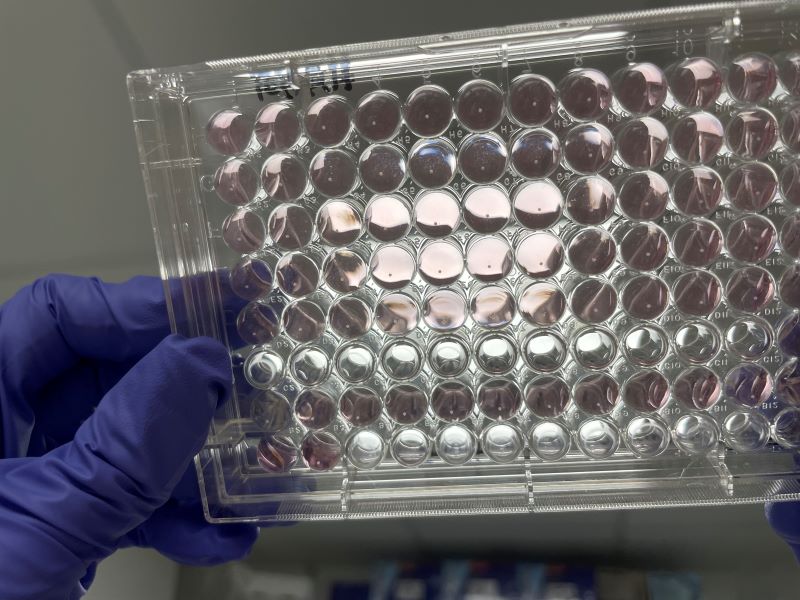
SpheroTribe improves the formation of unique & circular human glioblastoma spheroids
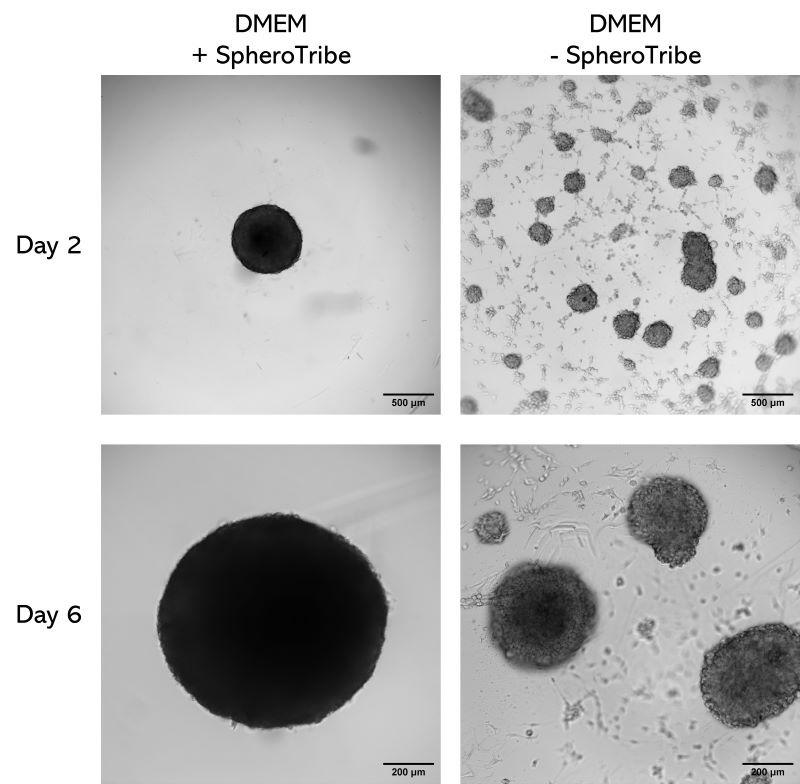
Human glioblastoma U87 cells were cultured in DMEM with or without SpheroTribe
in U-bottom plates and imaged after 2 days (4X magnification) and 6 days (10X magnification)
Patient-derived glioblastoma spheroid formed with SpheroTribe invading a 3D collagen-I matrix

Glioblastoma spheroids were included into a collagen matrix after being cultured in medium added with SpheroTribe solution for 4 days.
Images were taken immediately after (left) or 24 hours after (right) inclusion in the collagen matrix.
Image credits: (c) Thomas Daubon, 2023.
We are very satisfied with the SpheroTribe kit, which allows the reproducible and very simple formation of spheroids in 96-well plates. Since the first attempt, we have managed to form reproducible single spheres with various patient-derived glioblastoma cell lines.
Célia Lemoine • Université de Liège, Belgium, 2024
Immune infiltration of B16F10 spheroids after immune checkpoint blockade

A. 10,000 B16F10 cells were grown for 6 days as spheroids using SpheroTribe. B. 100,000 PBMC from murine spleen were activated with IL-15 (40 ng/mL) [1], incubated with anti-PD1 (10 µg/mL) for 1h and added on B16F10 spheroids for 3 days.
Graph shows flow cytometry quantification of differential lymphocyte infiltration after spheroid dissociation according to treatment. N=4. Mann-Whitney U Test, p-value<0.05. [1] https://doi.org/10.3389/fonc.2022.898732.
Image credits: Guillaume Mestrallet, PhD - Tisch Cancer Institute, Icahn School of Medicine at Mount Sinai, New York, US - 2023. @GMestralletPhD
Generation of reproducible patient-derived glioblastoma spheroids using SpheroTribe
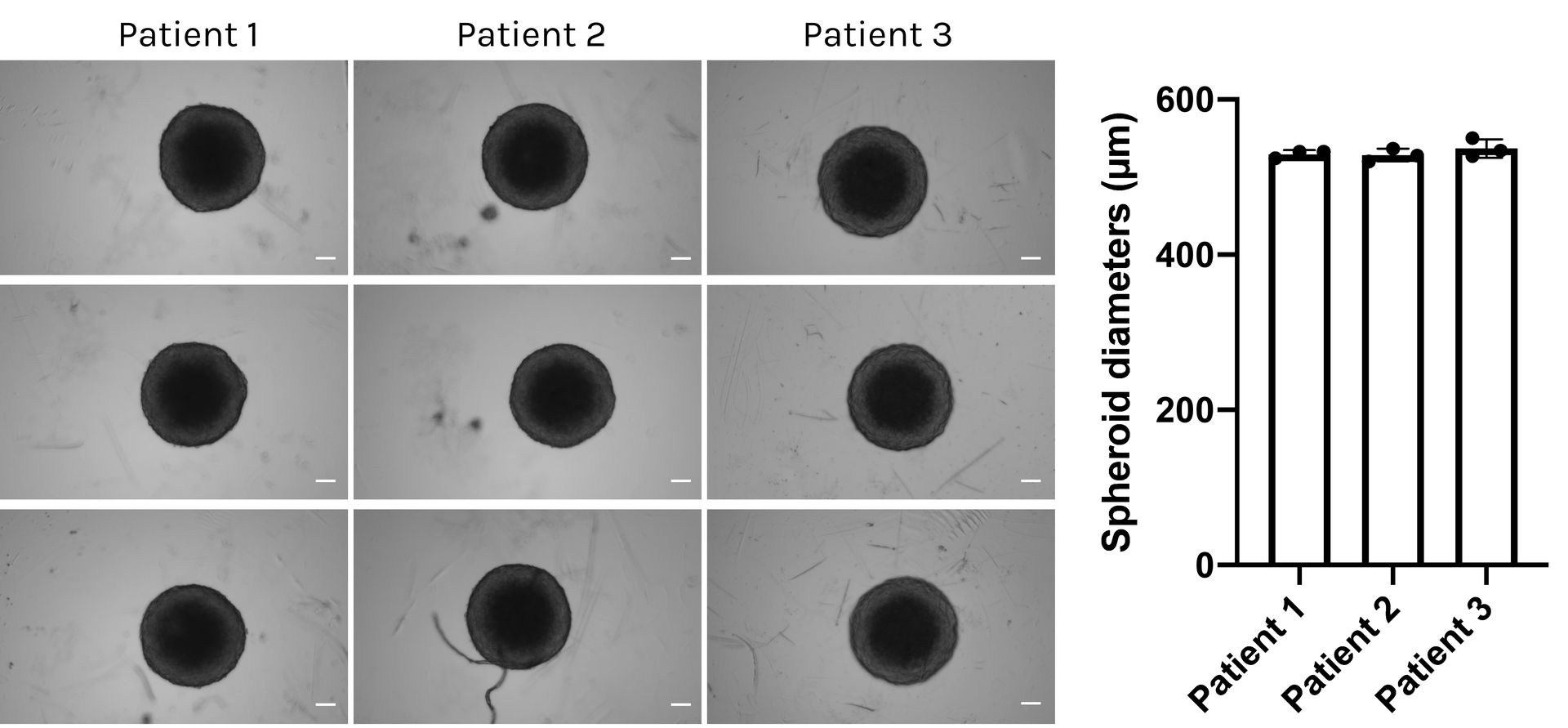
Various patient-derived glioblastoma cell lines were seeded in culture medium containing SpheroTribe in the 96-well plates provided at a density of 10,000 cells per well. The diameters of the obtained spheroids were measured after 3 days of culture.
Image credits: Célia Lemoine & Virginie Neirinckx - Faculté de Médecine, Université de Liège, Belgium – GIGA Neurosciences Project - 2024
Generation of consistent human breast cancer spheroids using SpheroTribe
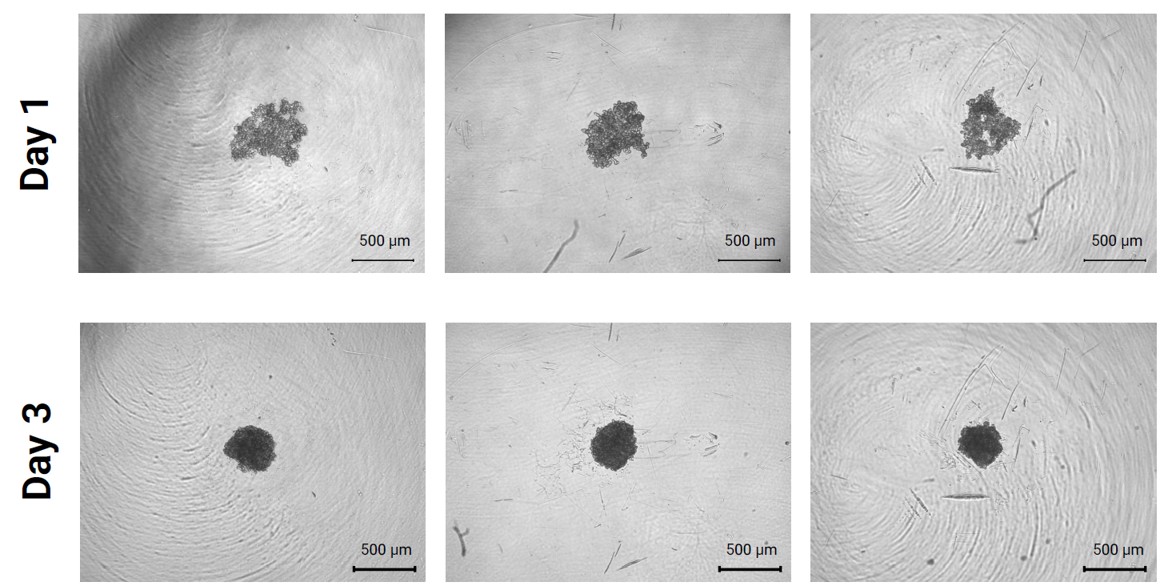
MDA-MB-231 cells were seeded in the provided round-bottom plates in culture medium added with 20% SpheroTribe (1,250 cells per well). Phase-contrast images were acquired after 1 and 3 days of culture in 3 independent wells.
Image credits: Filipa Mendes, Diogo Engrácia and Catarina Pinto, Instituto Superior Técnico, Universidade de Lisboa, Portugal
SpheroTribe’s key advantage is its easy manipulation, allowing the formation of spheroids with good physical characteristics and to obtain consistent invasion assays.
Filipa Mendes • Instituto Superior Técnico, Universidade de Lisboa, Portugal, 2024
SpheroTribe improves cardiac organoid formation by boosting initial hiPSC aggregation into embryoids

Human iPSCs were seeded in ULA plates in presence (left) or absence (right) of SpheroTribe solution (T=0) and cultured for 3 days following a self-assembling human heart organoid differentiation protocol [1]. The heart differentiation protocol was initiated at T +24h.
Image credits: Aitor Aguirre, Ph. D. - Michigan State University, US
[1] Lewis-Israeli, Y.R., Wasserman, A.H., Gabalski, M.A. et al. Self-assembling human heart organoids for the modeling of cardiac development and congenital heart disease. Nat Commun 12, 5142 (2021). https://doi.org/10.1038/s41467-021-25329-5
Spheroid forming and invasion potentials of CMV-elicited glioblastoma cells

Top panel: Confocal microscopic images of concomitant Nestin/IE1 staining in spheroids generated from isolated HCMV-GB and DB strains. Nuclei were counterstained with DAPI; magnification ×63, scale bar: 10 μm. Bottom panel: Microscopic images showing the invasion potential of CEBGCs-derived spheroids through protrusions (red arrows); magnification ×200, scale bar: 20 μm.
Source publication: Guyon, J., Haidar Ahmad, S., El Baba, R. et al. Generation of glioblastoma in mice engrafted with human cytomegalovirus-infected astrocytes. Cancer Gene Ther 31, 1070–1080 (2024). https://doi.org/10.1038/s41417-024-00767-7
SpheroTribe improves spheroid formation in agarose micro-wells
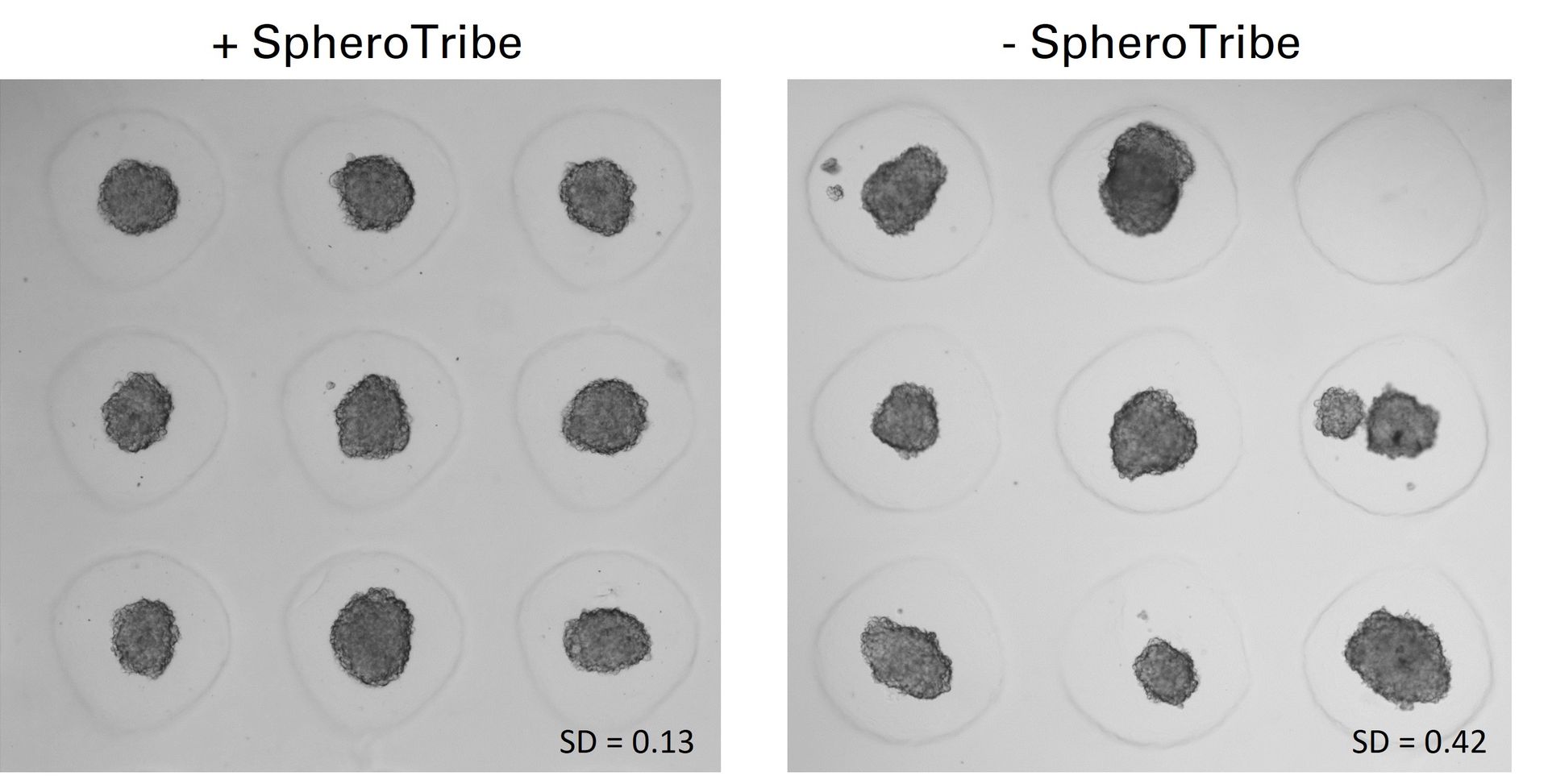
U-87 glioblastoma cells were seeded at 1,000 cells per well in round-bottom wells molded in agarose using a Stampwell U-shape (Idylle) in full culture medium without (right) or added with SpheroTribe (left). After 3 days, pictures were taken and number of cell aggregates per well were quantified from 64 independent wells and associated standard deviation (SD) values were calculated.
SpheroTribe promotes and maintains cell aggregation in COS-7 monkey kidney fibroblast-like cells

COS-7 cells were cultured in non-tissue culture treated U-bottom plates for 4 days in presence (up)
or absence (bottom) of the SpheroTribe concentrate. Scale bar = 500 µm
Assessing anti-cancer treatment effects on colorectal cancer spheroid migration using SpheroTribe

HT-29 cells were formed with SpheroTribe and treated with various plant-based anti-cancer compounds for 72h after 3 weeks of culture. Images were taken using a Cytation 1 reader.
Credits: Khosrow Rezvani, University of South Dakota, US
SpheroTribe promotes and maintains cell aggregation in HeLa cells
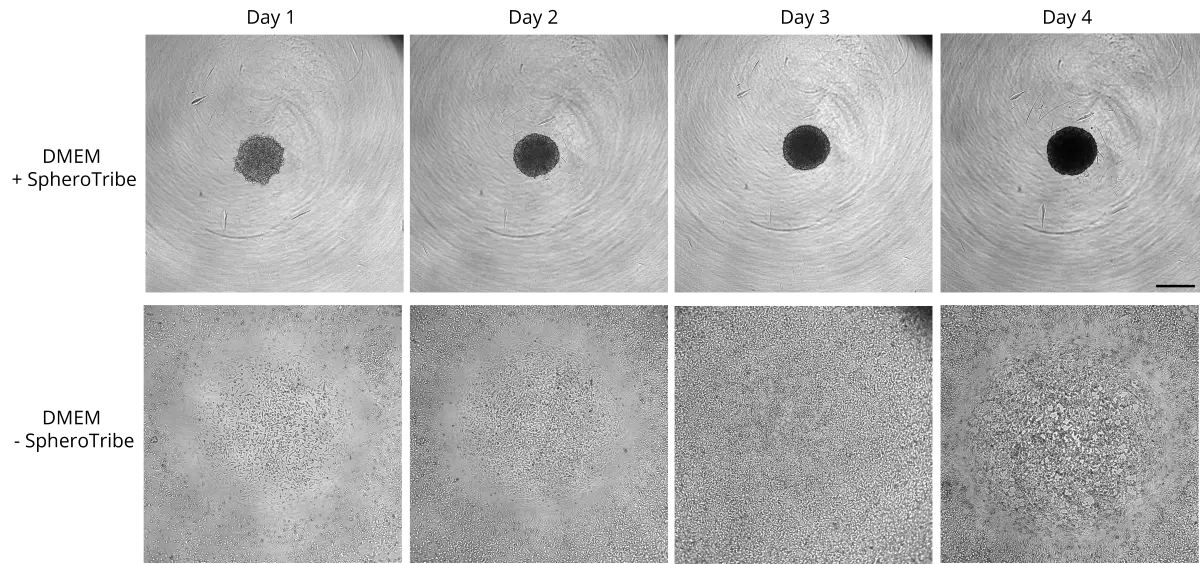
HeLa cells were cultured in non-tissue culture treated U-bottom plates for 4 days in presence (up)
or absence (bottom) of the SpheroTribe concentrate. Scale bar = 500 µm
How to use SpheroTribe in pictures
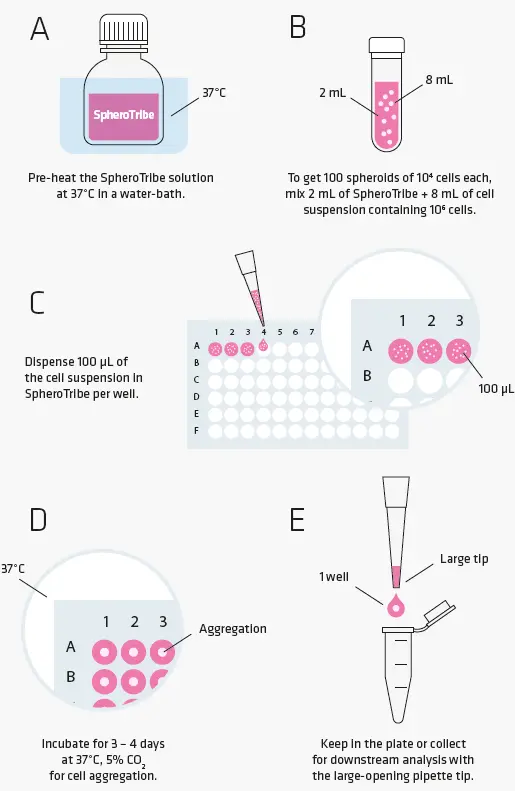
Need advice for your downstream assays? Check out our FAQ section for published protocols of immunostaining, invasion, migration, proliferation assays & in vivo spheroid implantation.
Watch the video protocol: How to use SpheroTribe
General enquiries
SpheroTribe relies on the use of methylcellulose, a crowding agent that is well-known to drive efficient cell aggregation into spheroids. Once diluted in culture medium, methylcellulose increases the viscosity of the medium, creating a gel-like environment that restrict cell movement and encourages cell-cell contacts for the formation of compact spheroids.
The SpheroTribe solution is composed of methylcellulose, a derivative of cellulose that is known to be biologically-inert, i.e. to neither actively contribute to biological responses or interfere with it. It is notably used in various biofabrication tools, including bioinks. In addition, SpheroTribe allows you to culture cells without exogenous ECM components, avoiding the known bias they may have on cell signaling.
In previous assays, the methylcellulose has been left in the culture medium throughout the whole experiment without any noticeable effects (i.e. immune infiltration assays, spheroid dissociation protocols for flow cytometry, addition of inhibitors for proliferation assays, etc).
If needed, the methylcellulose can be readily washed off at any stage of the protocol for subsequent assays.
So far, SpheroTribe has
been successfully used to generate spheroids/organoids with the following
cell types:
Patient-derived stem-like glioblastoma cells (GB P3, BL13, T033 & T042), human
glioblastoma cell lines (U87 & T98G), HeLa, human vaginal mucosal
melanoma (HMV-II), human primary colorectal cancer cells, human breast
cancer cells (MDA-MB 231), human colon cancer cells (HT-29), monkey kidney
fibroblast-like cell line (COS-7), primary neurons from rat embryos (E18) &
murine melanoma cells (B16F10), human induced pluripotent stem cells (hiPSCs)-derived organoids.
We would greatly appreciate your valuable inputs by helping us complementing this list with any of your positive research experiences. Drop us a message through our Contact page!
Yes, spheroids formed with SpheroTribe can be dissociated when preparing cells for flow cytometry measurements.
The SpheroTribe concentrated solution is made up in basal medium and does not contain any proteins, lipids
or growth factors. You can dilute it in any culture medium of your choice, and
add other compounds as desired (i.e. serum, antibiotics, etc).
One SpheroTribe kit contains everything you need to grow up to 960 unique spheroids. Total number of spheroids generated with one kit may vary depending on the concentration of SpheroTribe solution used for cell aggregation, total spheroid growth duration and frequency of medium renewal.
Yes, it is also
possible to buy the methylcellulose solution alone and use it to complement
your current method. Please contact us and we will send a dedicated quote.
Once formed, the spheroids generated using SpheroTribe can be used for any kind of downstream assays. The increased cell-cell contacts allowed by the methylcellulose will improve inter-spheroid homogeneity, and therefore greatly enhance your data reproducibility. So far, spheroids generated using SpheroTribe have been successfully used for invasion, migration, proliferation and immune cell infiltration assays, immunostaining procedures and in vivo implantation. If needed, the methylcellulose can be readily washed off and/or the spheroids transferred to other vessels at any stage of the protocol.
Protocol of use
The total time to initiate 3D cell culture with SpheroTribe should take no more than 30 minutes. After that, optimal culture duration to achieve desired spheroid size will vary depending on your cell proliferation rate and targeted application. As a general rule, compact & homogeneous spheroids are usually formed after 3 days of culture.
Optimal seeding density can vary greatly depending on the cell type, proliferation rate and targeted application. You will most probably need to start with a couple of optimization tests to find out which density will best suit your needs. As a general rule, we recommend using 10,000 to 20,000 cells per well for primary cells and 2,000 to 7,000 cells per well for tumoral/immortalized cell lines.
Spheroid sizes can vary greatly depending on cell type characteristics, initial density and culture conditions used. To help you select optimal conditions, here are a couple of examples of sizes reached for different cell types and seeding densities:
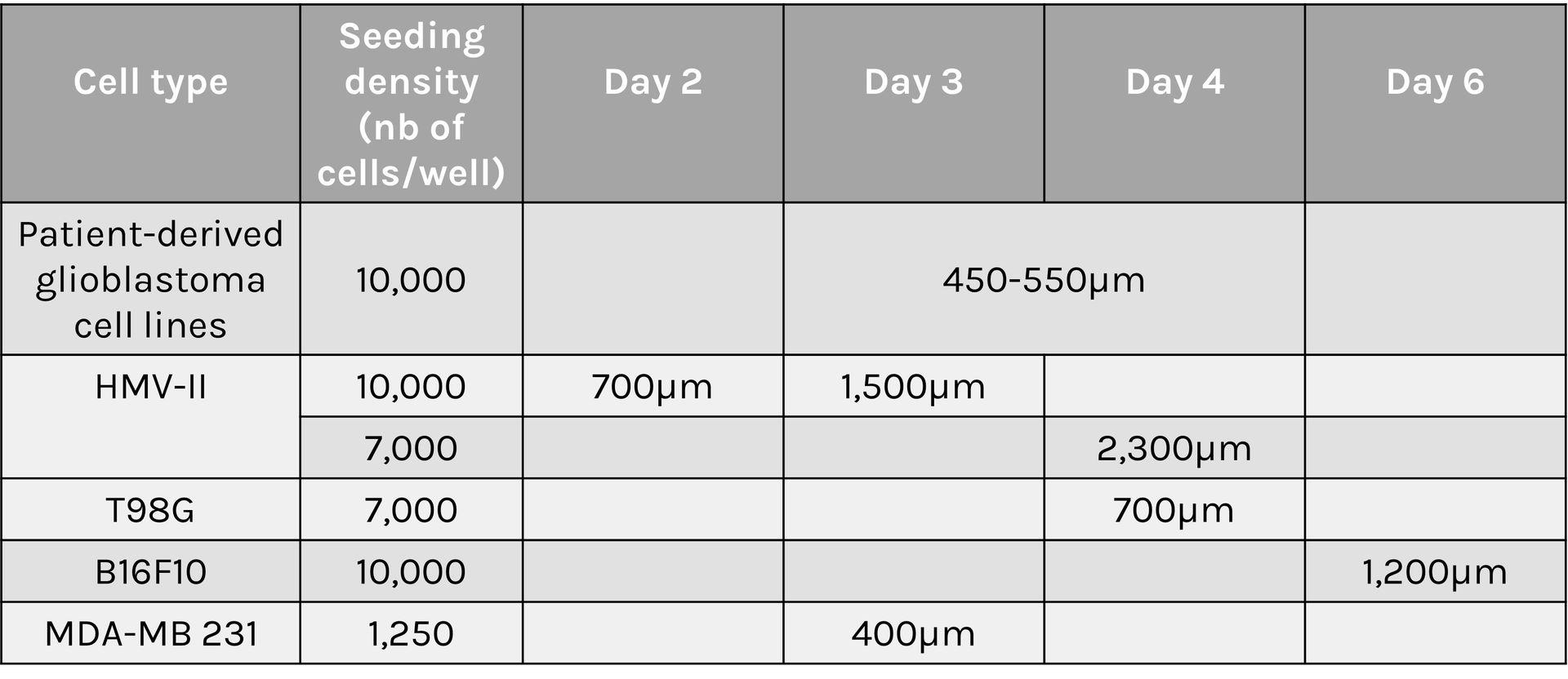
A variety of downstream assays have been performed with spheroids generated with SpheroTribe. We only provide a detailed protocol for the formation of spheroids, as this is what SpheroTribe is designed for. However, if needed, you can check out the following publications describing protocols for various assays using glioblastoma spheroids generated with SpheroTribe. These can easily be applied to other cell types:
- Invasion assay + Fiji macro for easy quantification of invasion, migration & proliferation: Guyon, J., Andrique, L., Pujol, N., Røsland, G. V., Recher, G., Bikfalvi, A., Daubon, T. A 3D Spheroid Model for Glioblastoma. <em>J. Vis. Exp.</em> (158), e60998, doi:10.3791/60998 (2020).
- Tumor spheroid immunostaining & mice intracranial implantation: Guyon, J. et al, Lactate dehydrogenases promote glioblastoma growth and invasion via a metabolic symbiosis. EMBO Mol Med (2022) 14/ e15343, doi:10.15252/emmm.202115343.
The SpheroTribe kit has been shown to generate unique & uniform spheroids with most cell types tested. Yet, when working with particularly challenging cells, here are a few tips to keep in mind to maximize your chance to obtain unique & uniform spheroids in each well:
- Starting from a single-cell suspension: the presence of cell clumps in your initial cell suspension at the time of seeding can compromise the obtention of unique & uniform spheroids. When starting from isolated primary cells, we recommend that you carefully dissociate cells using filters or columns if needed.
- Pre-heating the SpheroTribe solution at 37°C before use: lower temperatures will make it more viscous, potentially favorising the formation of multiple cell aggregates.
- If the above advice are not sufficient, centrifuging the plate at 300g for 3 minutes can help with spheroid formation.
Any other questions? Please contact us
Publications about SpheroTribe:
Original publication from the developpers :
A 3D spheroid model for glioblastoma, Journal of visualized experiments (JOVE), 2020. Joris Guyon, Laetitia Andrique, Nadège Pujol, Gro Vatne Rosland, Gaelle Recher, Andreas Bikfalvi, Thomas Daubon. (https://doi.org/10.3791/60998)
Other publications using SpheroTribe spheroids:
Dendritic cells type 1 control the formation, maintenance, and function of tertiary lymphoid structures in cancer, BioRXiv, 2024. Raphaël Mattiuz, Jesse Boumelha, Pauline Hamon, Jessica Le Berichel, Abishek Vaidya, Brian Y. Soong, Laszlo Halasz, Emir Radkevich, Hye Mi Kim, Matthew D. Park, Romain Donne, Leanna Troncoso, Darwin D'Souza, Medard Ernest Kaiza, Ian P. MacFawn, Meriem Belabed, Guillaume Mestrallet, Etienne Humblin, Raphaël Merand, Clotilde Hennequin, Giorgio Ioannou, Sinem Ozbey, Igor Figueiredo, Samarth Hegde, Alexander Tepper, Hajer Merarda, Erika Nemeth, Simon Goldstein, Amanda M. Reid, Moataz Noureddine, Alexandra Tabachnikova, Jalal Ahmed, Alexandros D. Polydorides, Nina Bhardwaj, Amaia Lujambio, Zhihong Chen, Edgar Gonzalez Kozlova, Seunghee Kim-Schulze, Joshua D. Brody, Michael Schotsaert, Christine Moussion, Sacha Gnjatic, Catherine Sautès-Fridman, Wolf Herman Fridman, Vladimir Roudko, Brian D. Brown, Thomas U. Marron, Jason G. Cyster, Hélène Salmon, Tullia C. Bruno, Nikhil S. Joshi, Alice O. Kamphorst, Miriam Merad. (https://10.1101/2024.12.27.628014)
Veratridine, a plant-derived alkaloid, suppresses the hyperactive Rictor-mTORC2 pathway: a new targeted therapy for primary and metastatic colorectal cancer, Research Square, 2024. Eikanger MM, Sane S, Schraufnagel KS, Slunecka JL, Potts RA, Freeling J, Sereda G, Rasulev B, Brockstein RL, Emon MAB, Saif MTA, Rezvani K. (https://doi.org/10.21203/rs.3.rs-5199838/v1)
Generation of glioblastoma in mice engrafted with human cytomegalovirus-infected astrocytes, Cancer Gene Therapy, 2024. Joris Guyon, Sandy Haidar Ahmad, Ranim El Baba, Mégane Le Quang, Andreas Bikfalvi, Thomas Daubon and Georges Herbein. (https://doi.org/10.1038/s41417-024-00767-7)
Histological analysis of invasive glioblastoma organoids embedded in a 3D collagen matrix, STAR Protocols, 2023. Joris Guyon and Thomas Daubon. (https://doi.org/10.1016/j.xpro.2023.102521)
Lactate dehydrogenases promote glioblastoma growth and invasion via a metabolic symbiosis, EMBO Molecular Medicine, 2022. Joris Guyon, Ignacio Fernandez-Moncada, Claire M Larrieu, Cyrielle L Bouchez, Antonio C Pagano Zottola, Johanna Galvis, Tiffanie Chouleur, Audrey Burban, Kevin Joseph, Vidhya M Ravi, Heidi Espedal, Gro Vatne Røsland ,Boutaina Daher, Aurélien Barre, Benjamin Dartigues, Slim Karkar , Justine Rudewicz, Irati Romero-Garmendia, Barbara Klink, Konrad Greutzmann, Marie-Alix Derieppe,Thibaut Molinie, Nina Obad, Céline Léon, Giorgio Seano, Hrvoje Miletic, Dieter Henrik Heiland, Giovanni Marsicano, Macha Nikolski, Rolf Bjerkvig, Andreas Bikfalvi & Thomas Daubon. (https://doi.org/10.15252/emmm.202115343)
Coordinated macrophage and T cell interactions mediate response to checkpoint blockade in colorectal cancer, BioRXiv, 2025. Guillaume Mestrallet, Matthew Brown, Natalie Vaninov, Nam Woo Cho, Leandra Velazquez, Aparna Ananthanarayanan, Matthew Spitzer, Nicolas Vabret, Cansu Cimen Bozkus, Robert M Samstein, Nina Bhardwaj. (https://doi.org/10.1101/2025.02.12.637954)